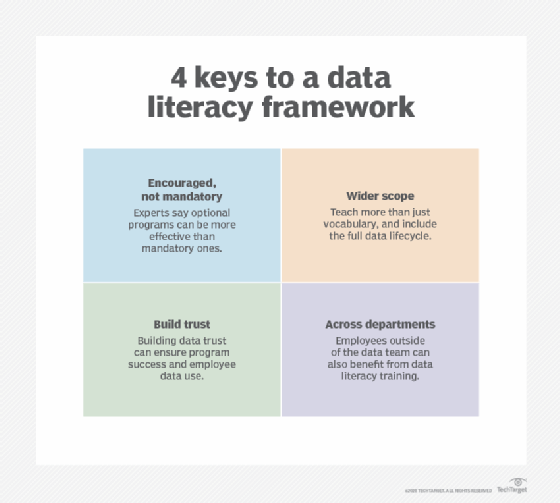
Sergej Khackimullin - Fotolia
Data literacy framework must-haves for enterprises
As data becomes increasingly important to enterprises, employees beyond the data team need to be data literate. And data literacy programs need certain components to succeed.
Competitiveness is driving companies to be more data-driven, as the need for insights and the ability to adapt rapidly to changing circumstances has never been greater.
As the importance of data and analytics grows within organizations and industries, more people have become data users by tapping into BI or analytics platforms or using applications that have embedded analytics capabilities.
But technology alone will not advance an organization's analytical maturity. Becoming data-driven requires a cultural shift that prioritizes data and analytics use throughout the organization. The commitment requires the support and involvement of senior leadership as well as training for employees.
What is data literacy?
Data literacy is often associated with data-related terms, but it involves a lot more than that. Specifically, data users should also understand where data came from, what data quality is and how to articulate an effective query. Training may also involve some basic knowledge of models and algorithms. Importantly, a solid data literacy framework also should also teach analytical thinking.
"We used to teach people how to use a tool," said Rita Sallam, distinguished analyst and Gartner fellow. "Now we have to teach people how to think critically, use data within their context and understand the concepts of where something is valid or not so they can make assessments about the insights that are being [presented] to them."
Why data literacy matters
Enterprises need data scientists, data analysts and citizen data scientists to solve the range of problems facing the organization. Data scientists and data analysts are trained to be more than data literate. Other employees require data literacy training so they can be more proficient in their jobs.
"There's a broader mindset that data matters to everyone, not just specialists," said Valerie Logan, founder and CEO of The Data Lodge, a data literacy consultancy. "Data literacy is about a foundation of shared language, not just data and analysis terms but business acumen combined with those. How do you engage with others? How do you take an action?"
Increasingly, positions with varying job descriptions require some level of data literacy, which means that organizations need to invest in upskilling employees, and employees must align themselves with the data-driven nature of today's business environment.

Data literacy in action
There are many ways organizations can approach data literacy. They can build their own data literacy framework, hire a consultant for training or pay for employees to take courses or certificate programs.
Open source enterprise software company Red Hat started its own program in March 2019, starting with a project lead.
"[As of] 2020, the amount of data that's ever been created equals about 59 zettabytes of data and by 2024, it's going to be 149 zettabytes of data," said Brian Kleinfelt, data literacy program lead at Red Hat. "If we don't really know and understand what we're doing in terms of how we're going to collect it, store it, analyze it, visualize it and then use it to make good, data-informed decisions, I really think that some organizations are just going to be left behind."
Data literacy training is optional at Red Hat, though Kleinfelt said the decision to participate or not could influence the direction of an individual's career since the number of positions within the company that don't use data are dwindling. He and others interviewed for this article said mandatory training programs don't work.
More fundamentally, Kleinfelt and Logan point out that using data is a life skill everyone uses to make decisions, whether it's voting for a political candidate or deciding what product to buy. Kleinfelt said the goal of Red Hat's program is to make people aware of what data they're using and how they're using it.
Kleinfelt started Red Hat's data literacy program by asking stakeholders about needs and reading everything he could find about data literacy frameworks and how other companies benefited from them. He also purchased some off-the-shelf training materials that covered basic statistics and other topics that were not unique to the organization.
Red Hat's program has since been broken down into beginning, intermediate and advanced levels of training. Foundational courses explain how Red Hat specifically uses data, how to ask good questions of data and basic analytical techniques. More advanced topics include how to use statistics, data visualization tools and data storytelling and how to make data-informed decisions.
Don't overlook the details
A data literacy framework could look different from one company to the next, but many share common features. In addition to teaching data and analytics vocabulary, it needs to provide practical how-to information and cover data lineage. In addition, employees should also be taught that data needs to be governed, secured and used ethically.
"Even if [everyone] were to [use] the same language, if someone doesn't trust the data, they're not going to use it," said Ruben Ugarte, founder of Practico Analytics, an analytics consultancy. "There needs to be some level of trust that the numbers are accurate, and they can look at reports and understand that this is really what's going on."
Bottom line
If your company wants to be data-driven, it needs to invest in a data literacy framework for the masses so everyone in the organization can derive more value from data insights. Data literacy involves more than just understanding and applying data terms. It also requires an understanding of the full data lifecycle and how data can be used responsibly to make better decisions.







